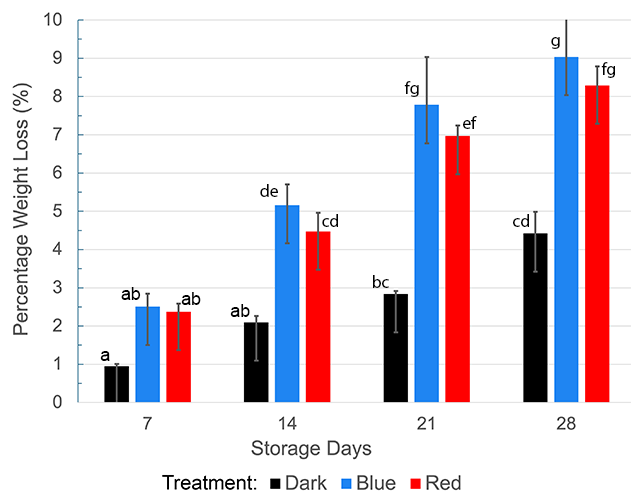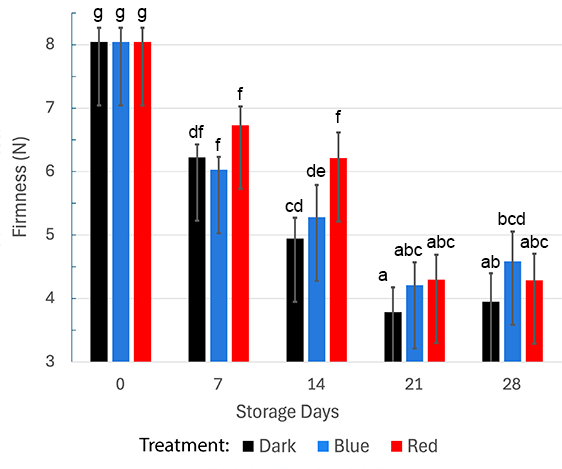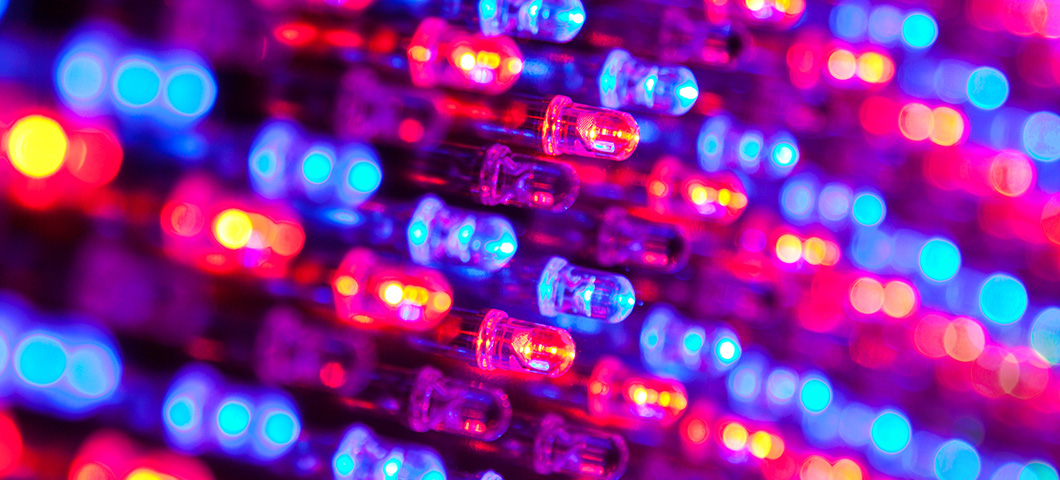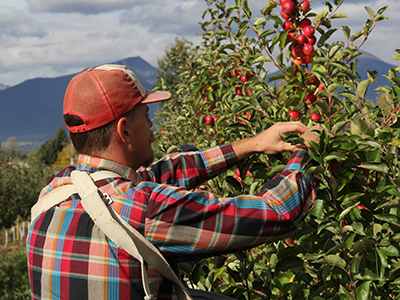Effect of LEDs on haskap postharvest storage
A website summary of Effect of Blue and Red Light-Emitting Diodes on Haskap (Lonicera caerulea L.) Postharvest Storage (https://doi.org/10.21203/rs.3.rs-6221609/v1)
by Zhuoyu Wang, Andrej Svyantek, and Zachariah Miller*
Western Agriculture Research Center, Montana State University, Corvallis, MT, 59828, USA; zachariah.miller@montana.edu
*Author to whom correspondence should be addressed.
Summary
This study explored how red and blue LED lights affect the postharvest storage quality of haskap berries (otherwise known as honeysuckle, Lonicera caerulea var. edulis). Refrigerated berries exposed to LED lighting were compared with those stored in darkness. While LED treatments helped maintain berry firmness, color, and antioxidant activity, they also caused greater moisture loss—an important factor in postharvest quality decline. The increases in anthocyanin concentration and antioxidant levels may be partly due to water loss concentrating these compounds, rather than a true enhancement.
LED lighting did not significantly affect sugar content, acidity, vitamin C, or microbial growth. Although red and blue LEDs show potential for preserving certain quality traits, further research is needed to reduce moisture loss and better understand the underlying mechanisms.
Introduction
Fresh haskaps (also known as honeyberries) are nutritious, delicious, cold-hardy berries. Fresh berries often command a higher price than frozen berries, but have a shorter shelf life. Earlier research at MSU-WARC has shown that fresh berries maintain acceptable quality in cool storage for 7–10 days, after which the marketability threshold of 10% severely shriveled berries is typically exceeded. In cool storage, the main quality issue is the berry’s tendency to lose moisture and firmness. Several preharvest (hexanal) and postharvest fruit treatments (aloe or chitosan) have shown some promise; however, these treatments are not always practical for small-scale and soft fruit operations.
Light-emitting diodes (LEDs) have been used in other fruits to slow spoilage, enhance color, and maintain nutritional quality during storage. Specifically, red and blue LEDs have shown different effects depending on the fruit and storage conditions. These lights can help improve shelf life, reduce spoilage, and even boost nutritional quality. Here’s an overview of previous research:
- Tomatoes: Red light improved skin color and increased lycopene (an antioxidant) but didn’t affect sugar levels.
- Melons: Red light sped ripening and increased sugar content
- Kumquats: Effective for degreening of postharvest fruit
- Berries: In raspberries and blueberries, pulses of red light (especially when combined with pulses of blue) helped maintain vitamin C and organic acid levels.
- Strawberries: Blue light, especially when combined with salicylic acid, kept berries firmer and fresher in cold storage.
- Peaches: Blue light sped up ripening at cool temperatures.
- Purple Peppers: Blue light slowed ripening—showing that effects can vary by crop.
- Blueberries: Blue light didn’t change quality much, but didn’t cause harm either.
- Bayberries & Grapes: Blue light increased sugar and acidity, improving flavor.
- Fungal Control: Blue light reduced mold and fungal growth on some fruits.
The present study explores whether red and blue LED lights can help preserve haskap berry quality during cold storage, focusing on changes in firmness, color, and antioxidant levels.
Study design
About 7.5 kg of ‘Aurora’ haskap berries were hand-harvested in July 2024 at Montana State University’s Western Ag Research Center. Within two hours, the fruit was cooled to 4°C (75–90% humidity). Only undamaged berries were used.
Berries were divided into three groups:
- Red LED (630 nm, 14 W/m²)
- Blue LED (475 nm, 14 W/m²)
- Control (darkness)
All berries were stored in a walk-in cooler (0–4°C, ≥90% humidity) in clear plastic commercial clamshell containers. Each treatment had 30 clamshells, and samples were taken at 0, 7, 14, 21, and 28 days.
- Weight Loss: Clamshells were weighed at each time point to track moisture loss.
- Color: Surface color was measured using a color meter to track changes in brightness and red/blue tones.
- Firmness: A handheld tester measured berry firmness using a small puncture test.
- Juice Quality: Crushed berries were tested for sugar (°Brix), pH, and acidity using handheld meters.
- Vitamin C: Ascorbic acid was measured using a lab kit after storing juice samples in the dark.
- Microbial Counts: Berries were blended in sterile bags, diluted, and plated to check for mold, yeast, and bacteria.
- Nutritional Compounds: Juice was tested for total phenolics, flavonoids, and anthocyanins using color-based lab kits.
- Antioxidant Capacity: Two standard lab tests (DPPH and FRAP) were used to measure antioxidant capacity.
Findings
All berries lost moisture over time, but those stored under red and blue LED lights lost more—up to 7–9% by Day 28—compared to 3–4% in the dark. This may be due to slight warming or light-related stress. Adjusting light intensity or duration could help reduce this loss.

Figure 1. Berry weight loss over a 28-day cold storage period under red LED light, blue LED light, and darkness. The column chart displays mean values with standard error bars. Both red and blue light treatments resulted in significantly greater weight loss compared to darkness, with effects becoming pronounced at two weeks and beyond.
Sugar levels (°Brix) remained stable across all treatments, ranging from 15.5 to 18.0. pH values shifted slightly over time (2.79–3.01), but not due to the light treatments. Acidity also stayed consistent.
LED lights affected berry skin color. Red and blue LEDs slightly reduced red tones and increased lightness, though these changes weren’t always visible. Firmness was better preserved under RED LED treatments, with berries staying slightly, but measurablely firmer than those stored in the dark at 14 days in storage—an advantage for handling and shelf life.

Figure 2. Postharvest treatments on haskap berry firmness. Bars represent mean values ± standard errors. Different letters indicate mean values that are significantly different (p<0.05) according to analysis of variance (ANOVA) and Tukey post hoc test. Red light significantly increased firmness, relative to the dark (control) at 14 days.
- Polyphenols and Flavonoids: These remained stable across all treatments. Juice samples showed 1.8–2.5 mg/mL of polyphenols and 1.3–3.0 mg/mL of flavonoids.
- Anthocyanins: These increased during storage, especially under LED lights, suggesting improved color and antioxidant potential over time.
- Vitamin C: Ascorbic acid levels stayed steady throughout storage, regardless of treatment.
LED lights maintained or even boosted antioxidant activity in haskap berries. Although both DPPH and FRAP assays indicated improvements, only FRAP values were significantly elevated under red and blue LED treatments—particularly on Days 14, 21, and 28. However, beyond two weeks, berries are likely unmarketable due to excessive shriveling.
Table 1. Antioxidant capacities (as measured by Ferric Reducing Antioxidant Power (FRAP) assays of haskap across postharvest storage. Red and blue lights maintained antioxidant activities, and in the dark, they declined after 14 days.
|
Storage time (days)
|
Red
|
Blue
|
Dark
|
p-Value
|
|---|---|---|---|---|
|
0
|
166.17 ± 57.04
|
166.17 ± 57.04
|
166.17 ± 57.04
|
166.17 ± 57.04
|
|
7
|
127.23 ± 44.48
|
105.44 ± 26.94
|
137.49 ± 18.55
|
0.39
|
|
14
|
146.25 ± 14.83
|
172.12 ± 70.19
|
71.02 ± 6.68
|
0.02*
|
|
21
|
177.44 ± 23.64
|
146.11 ± 5.05
|
102.11 ± 9.73
|
0.0002**
|
|
28
|
195.66 ± 35.61
|
250.73 ± 85.43
|
120.99 ± 49.66
|
0.04*
|
The data are shown as values ± SD. SD is the standard deviation. P values show ANOVA statistical test results. * and ** Indicate statistically different (p < 0.05 and p < 0.001).
No visible mold was observed. Yeast and mold counts roughly doubled over 28 days (from 2.25 to 4.0 Log CFU/g), but LED treatments did not significantly affect microbial levels compared to the dark. Aerobic bacteria remained very low throughout storage.
Conclusions
Haskap berries are rich in health-promoting compounds, but their short shelf life limits their potential in fresh markets. This study is the first to investigate the effects of red and blue LED lighting on postharvest storage of haskaps.
While LED treatments helped maintain berry firmness, color, and antioxidant activity during cold storage, they also led to greater moisture loss compared to dark storage. This weight loss may have contributed to the observed increases in anthocyanin concentration and antioxidant capacity, rather than indicating a true enhancement of these compounds.
Given that moisture loss is a key factor in postharvest quality degradation, the practical benefits of LED lighting for haskap storage remain uncertain. Future research should focus on minimizing weight loss—potentially by adjusting light intensity or exposure duration—and clarifying the mechanisms behind chemical changes. With further refinement, LED lighting may still offer a viable strategy for improving shelf life and quality, but its application requires careful optimization.
Funding acknowledgement
This research is funded by the Montana Department of Agriculture, the Specialty Crop Block Grant Program. Grant No.: AM22SCBPMT1127.


